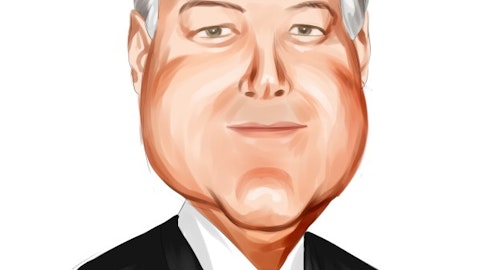Al Miralles: Sure. So Erik, obviously, we’re within our stated range, and I noted that our new leverage range is 2x to 3x. So certainly, we have room in that regard. And I would say as we think about M&A, certainly, smaller bolt-on as we’ve certainly done plenty of. We can do that with free cash flow and with our existing net leverage capacity. As we think about things bigger, obviously, we’re going to look at what’s the best use of our capital, which could include taking on more debt and could include other avenues. I will just note that while our goal is to stay within that investment-grade capital structure. Certainly, from the rating agencies, we get some room there that if you do larger M&A and you go beyond that, you have a grace period, if you will, and you have time that you then get back into that range. So all of that would be contemplated in our calculus as we think about deals.
Erik Woodring: Okay. Totally understand. And then, Chris, I’m not sure who wants to take this one. But generally, I think we’ve been hearing in the market kind of more weakness at the large enterprise level versus SMBs, your results would somewhat suggest the opposite with small business down versus the corporate business up. And so can you maybe just talk about some of the high-level trends you discussed in terms of extra signatures or deal downsizing, how that differs between the corporate business versus SMB business, if you are seeing any differences there? And again, same thing. I know we asked about pricing earlier on this call, but any difference in pricing between corporate versus SMB? And that’s it for me. Thanks.
Chris Leahy: Okay. Erik, yes, so differences between enterprise and SMB in terms of the process. I would say that the — look, larger enterprises have a muscle for this and we’re dealing with that muscle, and we know how to deal with the muscle. The smaller business, frankly, turn to us for cost evaluation as a trusted partner. And so in some ways, we actually play this avid role with them, which is how do you figure out, where you make adjustments in your technology roadmap to achieve the cost effectiveness. So in terms of the behavior itself, I’d say small and medium-sized businesses are being cautious. Enterprises have kind of kicked in their muscle and they’re doing the analysis that they do. But all of that said, we do continue to feel strong demand across all of our segments.
Even K-12 that we’ve talked about, that was a real dynamic in the quarter. We’re still very successful with them with network modernization, all the things that have to support the client devices. It’s the demand. Demand is okay right now.
Operator: Our next question comes from Shannon Cross from Credit Suisse. Your line is now open.
Shannon Cross: Thank you very much. I was wondering, can you talk a bit about working capital requirements as your model turns more and more to netted-down? I know this inventory levels came down quarter-over-quarter even with the shortfall in PCs and you’ve raised your target for free cash flow. So just how do you see your cash flow and balance sheet morphing over time? And then I have a follow-up. Thank you.
Al Miralles: Good morning, Shannon. So a few things. One, our — we talked about our rule of thumb for free cash flow, and we raised that and I would say that’s a reflection of our continued improvement and progress on really effectively managing working capital and also a somewhat of an effect or supported by the countercyclical nature of the business. So obviously, as this economic environment kind of moderates a bit, it actually helps from a cash flow perspective. So both of those things kind of in play. Your comment about netted-down or question about netted-down is a good one. It is a bit of a mathematical exercise. But just recall with our netted-down revenues, that while they show up in our net sales net, we’re actually collecting gross dollars.
So what that does from a cash conversion cycle perspective, it actually has the tendency to increase the DSO, increase DPO given the denominators and the numerator. So the way we think about that is really on a net basis. And can we continue to make progress within that band of high teens, low-20s on cash conversion. So all of those factors we consider as we’re managing the business, including the puts and takes relative to our investments in inventory as well as how we manage AR and AP. So that’s all part of really a dynamic operating model around working capital, and we’re making really good progress on that front.
Shannon Cross: Great. Thank you. And then can you talk a bit about demand you’re seeing for Device-as-a-Service, Infrastructure-as-a-Service? It seems like in a challenged end market; maybe the ability to pay more ratably would be gaining some traction. But I’m just curious as what you’re hearing maybe both from an enterprise standpoint as well as SMB. Thank you.
Chris Leahy: Yes, Shannon, I’ll take that. On the Infrastructure-as-a-Service, that is picking up. Our OEMs have been building that capability over time. And I’d say we’ve hit an inflection point where customers are eager to learn more and invest primarily enterprise, I would say, is a little stronger than the demand that we’ve seen in small business. On Device-as-a-Service that’s a little more complicated because on the one hand, while it’s an obvious of interest type solution. It’s more complicated if it’s either a lease or it’s more complicated than that. And so it hasn’t taken off to the extent that one would think, but may in the future.
Operator: Our next question comes from Jim Suva from Citigroup. Your line is now open.
Jim Suva: Thank you so much. I have a question on, there’s been a lot of like government stimulus programs. I was wondering how you’ve been seeing those rollout develop; embrace any potential red taper slowdowns in them or accelerations of that? Thank you so much.
Chris Leahy: Jim thanks for the question. Well, can I say they’re rolling out as they typically do? And sometimes, that includes red tape and not all the things that you expect with government. I mean seriously, there’s — when we think about the federal budget that was passed, we’re used to dealing with that, and we know where we can go find the funds. And I think that’s been pretty kind of standard operating procedure, if you will. The Infrastructure Act is a little more to figure out where funds that can benefit our customers’ vis-Ã -vis technology that’s taking a little bit more time is what I’d say. But it’s nothing that is daunting us or nothing that concerns us, frankly.
Jim Suva: Okay. And have you also been finding a lot of those new programs and systems have been kind of more on a higher-end service product offerings that you’ve had, say, today versus 5 or 10 years ago, meaning more like cloud and security and software solutions as opposed to more kind of plug-and-play hardware solutions?
Chris Leahy: Yes. That’s — that’s a great point. The ability to access that funding for more advanced solutions is absolutely there. There’s more demand for that versus merely client devices, for example. That’s a good point. Security, another one that you tends to thread through all of the funding mechanisms at this point. So yes, that’s a good point. And the answer is yes.
Operator: Our next question is from Keith Housum from Northcoast Research. Your line is now open.
Keith Housum: Good morning. Appreciate the opportunity. Chris, just looking at the hiring that you guys did over the year, 1,100 people through the first three quarters and then obviously, you guys were flat in the fourth quarter. I guess two things. One, is that kind of a testament to your thoughts on the overall market, perhaps weakening here as you guys went through the fourth quarter? And then what kind of people were you hiring during the year in order to meet your needs?
Chris Leahy: Yes. Keith, good morning. As we’ve been doing over the last few years, we’ve really been targeting our hiring in a couple of areas. It was the high demand, high capability. So think about the sales organization, think about the practice areas like technical specialists and security and cloud, software, the spaces that we’ve talked about and really targeting those areas. Along with what I would say is technologists and digital specialists for our own evolution of our business. That’s really where we’ve been focusing. In terms of as we come into the back half of the year, just consider that disciplined management of the business. As we look out at the economy, as we see what’s happening, we’re just being very disciplined in the way that we’re approaching our own cost management. And you’ll see that in some tempering in our hiring in the back half of the year.
Keith Housum: Great. I appreciate it. And then looking at your guide a little bit more, trying to unpack it. As you think about like the macro environment, are you expecting roughly a flat GDP? And where are you — what kind of assumptions are you making for interest rates as you guys think about your guide?
Al Miralles: Yes. Good morning, Keith. I would say just in terms of broad macro GDP, yes, I’d say flat, maybe slightly down, if you will. And so you get your translation from an IT market perspective with all of the components that we talked about, both our mix and uncertainty as well. Interest rates — look, I don’t know if we have a formal market view on that. Certainly, we make sure that the posture of our capital structure is protecting against that. We do have largely a fixed rate capital structure but we do have a component of our debt that’s term loan, that’s adjustable rate. And so the way we think about that is the most effective way to manage our interest rate risk is where we see there’s risk there that we might pay down that debt a bit faster. You saw that in the fourth quarter, and we’ll continue to operate in that regard. And obviously, we think about that in the construct of our overall capital priorities.





